Janet Wilson, Palm Springs Desert Sun
Tue, January 10, 2023
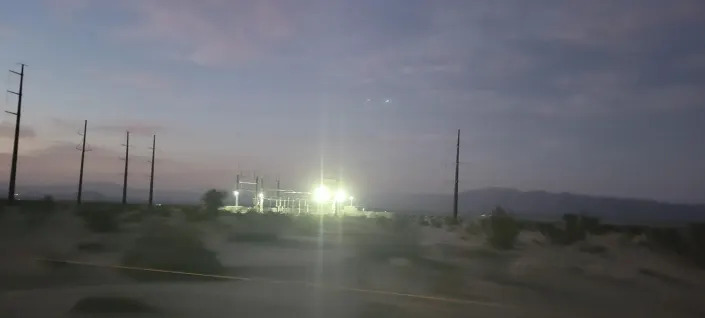
Lights from a solar transfer station taken at night from Lake Tamarisk retirement community in Desert Center, CA. December 2022
Mark Carrington, 72, thought he had found his piece of heaven in the vast California desert two years ago, when he bought a trailer pad in Lake Tamarisk Resort in Desert Center, 70 miles east of Palm Springs. He parked his RV and prepared to live out a peaceful retirement. The dark, star-spangled night skies and soaring mountain vistas of Joshua Tree National Park were a thrill.
Then the jackhammers started pounding and a pall of dust blotted the open sky.
He and other neighbors in the 55-plus community were shocked to learn a large-scale solar project called Oberon was being built on 2,600 acres of land, half a mile from their homes. Mature trees were ripped out, shrubby desert scraped bare, and the birds, rabbits, foxes and occasional desert tortoise disappeared. Then they learned two more huge projects have been proposed, including one 750 feet from their homes, Carrington said.
All told, they calculated the U.S. Bureau of Land Management and Riverside County have now approved nearly 18,000 acres of large-scale solar in the area. Another 6,000 acres of development are being weighed. And the projects, first built several miles away, are coming closer and closer, complete with truck traffic, chain link fencing and searing night lights on workstations and solar inverters.
“It’s very frustrating,” Carrington said. “When these projects are complete this will literally be like a prison compound. We will no longer be an oasis in the middle of a living desert, we will be an island in a solar sea that’s completely dead.”
More could be on the way.
Federal officials are now considering a major expansion and possible modification of designated solar zones on public lands across the West, to include five more states, wind as well as solar projects, and slopes as well as flat areas. The agency will kick off a dozen public “scoping meetings” on the redesign effort on Friday via a virtual session and an in-person meeting in Sacramento on Jan. 18.
BLM Director Tracy Stone-Manning said in a prepared statement that the agency “is committed to expanding renewable energy development on public lands to help lead the nation into a clean energy future, enhance America’s energy security, and provide for good-paying union jobs. She added, ”“We look forward to hearing from the public on effective ways to expand our nation’s capacity for producing solar energy while continuing to ensure robust protection of our public lands and waters.”
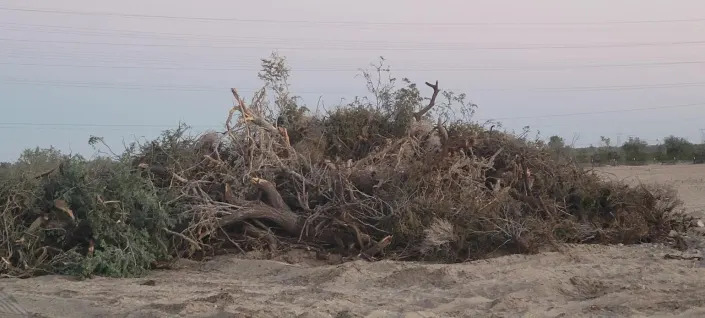
Chopped, destroyed ironwood trees on land cleared for Oberon solar project, Desert Center CA. in late 2022.
For Carrington and others in this tight-knit, isolated hamlet 50 miles from a grocery store, it's the latest blow in what they call the eradication of their community identity and way of life. The study also may look at amending California’s 10 .8 million acre Desert Renewable Energy Conservation Plan, a separate, hard-fought and carefully negotiated compromise agreement between federal and state agencies, developers, environmentalists and others that designated both development zones and conservation areas.
Renewable energy trade representatives say modifying the plans could actually reduce conflicts between rural residents and developers.
"There's plenty of land," said Ben Norris, senior director of regulatory affairs for the Solar Energy Industry Association, based in Washington, D.C. “We actually think certain changes would open up more lands for solar away from populated areas,”
But residents here are not convinced.
"I don't like it," Carrington said, noting many of the slopes and what remains of the open space around them are part of carefully preserved "areas of critical environmental concern" that should not be modified. They're already battling two more proposed projects, the Easley and the Sapphire solar farms, that they knew nothing about until they started sleuthing.
Public notice is an ongoing concern. Residents of the retirement park were not notified of the potential major expansion, despite promises by BLM officials that they would be added to official lists after they discovered the two other huge solar projects.
Carrington and his neighbors in the retirement park say they also were not notified in advance by federal or county officials or the developer, Intersect Power, about the Oberon project. Now they want a 5 mile buffer zone between their rural community and any more renewables, including Easley and Sapphire.
Their timing might or might not be good.
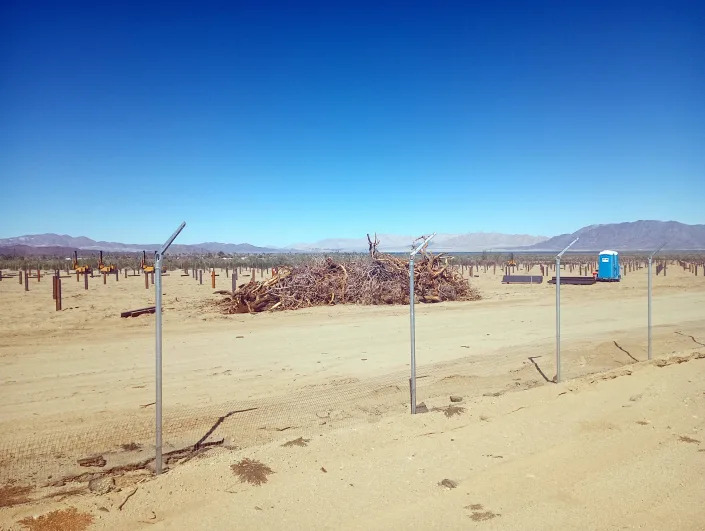
Ironwood trees leveled for new large-scale solar farm in Desert Center, CA
Push is on for large renewables across the West, amid rural objection
With climate change and its impacts taking hold, federal officials are now weighing broadly expanding but also potentially modifying development zones for large-scale solar and wind projects across the West, including in the California desert, where industrial renewables proposals have faced local backlash. Neighboring San Bernardino County in 2019 banned large renewables projects on 1 million acres of private land, including near 14 rural communities, after loud protests from residents.
To do it, the BLM may amend its sweeping 2012 Western Solar Plan and a related "programmatic environmental impact statement" that governs commercial solar development on public lands in six southwestern states: Arizona, California, Colorado, Nevada, New Mexico, and Utah. A new, sweeping environmental impact study designed to cover millions of acres in one fell swoop will weigh adding energy development zones in five more states: Idaho, Montana, Oregon, Washington and Wyoming, and may include wind power areas and hilly slopes left out of the original plan. Ultimately, as with the current plan and its accompanying PEIS, it could streamline renewable development in designated areas, and allow set-asides of other lands when habitat and species destruction can’t be avoided.
Most of the approvals issued by BLM since 2012 for solar projects have actually occurred via variances for work outside the designated areas.
Industry trade officials are highly supportive. They say while initial mapping of so-called solar energy zones, or SEZ’s, was done with good intentions by the Obama administration, they have not worked perfectly on the ground. They say it’s time for an update that might better avoid rural communities and truly expedite clean energy.
Norris with the solar industry group noted the current plan and PEIS only allow projects on flat land and with high solar radiation, which was done to fit now largely out-of-date technology.
“Easing those limits would, first, align the document with current 2023 technologies, and second, allow companies to consider more sites that could present lower potential for issues with surrounding communities.” said Norris. ”We very much appreciate BLM’s efforts to take another look at this high level environmental review document.”
He said North Dakota should also be added, and added that a 2021 Department of Energy report had found up to 10 million acres of renewable projects are needed to decarbonize the country’s electric grid by 2050. The 2012 Western Solar Plan designated about 285,000 acres as priority solar energy zones and excluded about 79 million acres from solar development. The plan also identified 19 million acres available for development under a variance process.
But Carrington and neighbors say despite being told by BLM they would be notified 15 days in advance of any new activity, they learned about the potential huge redesign effort accidentally, when he was searching for a phone number of a local staffer on the proposed Easley project. They’re also not happy that the California meeting will be in Sacramento, not in eastern Riverside County.
“How are we supposed to get there?” Carrington asked. “They should come here, and see where it’s happening.”
BLM press secretary Brian Hires, in response to questions from The Desert Sun, said in an email that the proposed update includes lands across California. ”The BLM determined that holding a meeting in Sacramento would allow for significant public participation.” He also noted the agency “will hold two virtual meetings accessible to the public for those that are not able to attend an in-person meeting.”
The study may also look at California’s 10 .8 million acre Desert Renewable Energy Conservation Plan, a separate, hard-fought and carefully negotiated compromise agreement between federal and state agencies, developers, environmentalists and others that designated both development zones and conservation areas.
Choking dust, lost views and water worries
The clock is ticking. BLM is pushing to meet a 2020 mandate set by Congress under the Trump administration, requiring them to authorize at least 25 gigawatts of renewable power by 2025,, enough to power close to 19 million homes.
Within a week of taking office, President Joe Biden signed an executive climate change order that in part requires the Secretary of the Interior to “review siting and permitting processes on public lands” to increase “renewable energy production on those lands . . . while ensuring robust protection for our lands, waters, and biodiversity and creating good jobs.”
As of last month, BLM, which reports to the Interior Secretary, had permitted 34 projects expected to produce 8,140 megawatts of electricity, about a third of the required 25 gigawatts by 2025, Hines said. Projects to produce nearly 3 gigawatts more are undergoing federal environmental reviews. Those totals include about one gigawatt built or is underway in and around Desert Center, enough to power about 750,000 homes.
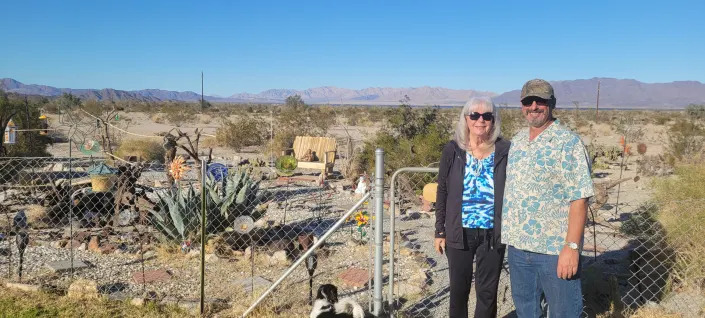
Teresa and Skip Pierce, retiree residents of Lake Tamarisk Resort retirement community in Desert Center, CA
Teresa Pierce, 70, and a resident of the Lake Tamarisk retirement community for six years, is helping spearhead community opposition to more huge projects in their area. She said industrial projects on fragile desert landscapes are the wrong path to slowing greenhouse gas emissions from power production.
“Really it should be on every rooftop in California and the nation,” she said. They “should not destroy deserts, since they sequester the carbon dioxide (the main greenhouse emitted into the atmosphere), and therefore disturbing the soil releases it.”
Norris with the solar trade group and some national environmental groups say rooftop solar and commercial solar are both needed.
Area environmentalists and tribal members who’ve opposed specific projects in the past are keeping a wary eye on the proposal, which they note is in the early stages. They also point out that any increased commercial development must be examined in the context of separate federal and state proposals, dubbed “30 by 30,” to preserve nearly a third of available and valuable open spaces by 2030.
"We look forward to seeing concrete proposals once scoping is complete," said Chris Clarke, associate director of the California deserts program for the National Parks Conservation Association. "We strongly feel that the DRECP should be taken as a working model and not amended or weakened, and that overall landscape level planning in other states is a must, and that planning HAS to protect areas of significant resource conflict from development. This process absolutely must not undermine the administration’s 30 by 30 goals."
Close to home, Pierce said the traffic from Oberon construction is “horrible,” and she and other mostly older residents now suffer from allergies, aggravated COPD and other woes from the dust. Those and other concerns were laid out in a comment letter submitted to Riverside County planners last week about the proposed Easley project, signed by scores of residents. They include the possibility of dangerous silica being present in windblown construction dust, excessive water being drawn from an ancient underground aquifer for the solar projects, and the loss of dark night skies and daytime hiking routes.
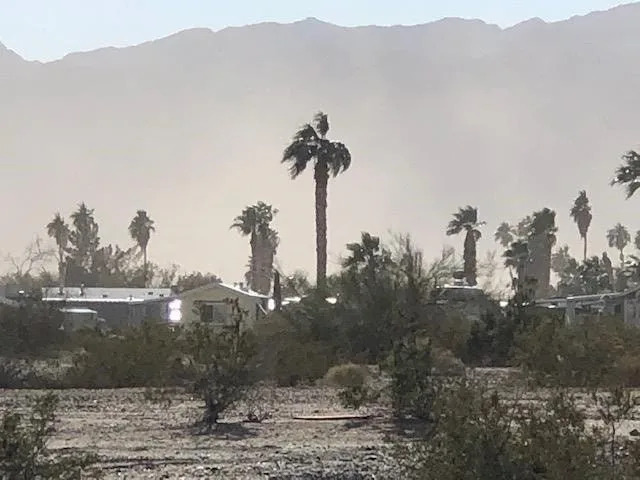
Fugitive dust from the Oberon commercial solar construction project, one-half mile south of Lake Tamarisk retirement community in Desert Center, CA. Taken December 11, 2022 at 9:30am during 16 mph southwest winds, with gusts to 30 mph.
Solar developer pushes back
An Intersect Power representative gave a different version of what has occurred with the Oberon project, and said the Easley project is in the very early stages.
“The Oberon project represents one of the largest habitat mitigation efforts of any single energy development project in California’s history, and is a great example of clean energy and conservation going hand-in-hand,” wrote Elizabeth Knowles, Intersect’s Director of Community Engagement, in an email. “This project will permanently protect nearly 6000 acres of high quality desert habitat for the Mojave desert tortoise, the desert kit fox, migratory birds, and other protected species.”
While that habitat is off-site, she said, “the Oberon … development footprint also avoids about 2,000 acres of sensitive on-site habitat for wildlife, ensuring habitat connectivity between conservation areas north and south of the project. The Oberon project is also complying with hundreds of conservation and mitigation measures to protect public health and safety and the environment.”
In December 2021, as that project neared final approval over objections from area environmentalists,, an Intersect spokesman said in total 80 acres or less of woodlands would be cleared on the 2,600 acre site, and areas of impact in a buffer zone had been reduced to about 55 acres.
Knowles said the public was notified about the Oberon project via BLM press releases and notices published in the Federal Register. The latter is a voluminous daily record of legal activity by more than 400 public agencies and the White House. She said while the Easley project “is in the very early stages of development and design decisions have not yet been finalized,” it could not be moved to a new location.
“We actively explored siting the Easley project in alternative locations, including east of Hwy 177, but the area was technically prohibitive,” she said.
But, she added, “the Lake Tamarisk community is actively involved in the public process for the Easley project. Since being made aware of their concerns, we have been in close contact with (them) and surrounding neighbors to understand and address any questions and concerns they have regarding our projects in the Desert Center Area. We will continue to work with them throughout the planning, construction and operations of the project.”
Carrington and Pierce said Knowles and other Intersect staff had met with them on Pierce’s patio, and the company might consider dimming or redirecting powerful night lights to help keep the skies above dark. But they said such small measures would do little.
“What’s occurring is just a pure disregard for us as a community, and us as human beings,” Pierce said.
In addition to Sacramento, BLM will hold public scoping meetings in Phoenix, Arizona; Grand Junction, Colorado; Washington, DC; Boise, Idaho; Billings, Montana; Albuquerque, New Mexico; Reno, Nevada; Bend, Oregon; Salt Lake City, Utah; Spokane, Washington and Cheyenne, Wyoming. A second virtual meeting will be held on Feb. 13.
Public comments will be accepted for 15 days after the last public scoping meeting. For the most current information, to register for the virtual sessions. and to view related documents, visit BLM’s ePlanning web site at https://eplanning.blm.gov/eplanning-ui/project/2022371/570.
Janet Wilson is senior environment reporter for The Desert Sun, and co-authors USA Today's Climate Point. She can be reached at jwilson@gannett.com and on Twitter @janetwilson66
This article originally appeared on Palm Springs Desert Sun: Feds may expand solar and wind across the West, including the CA desert
No comments:
Post a Comment